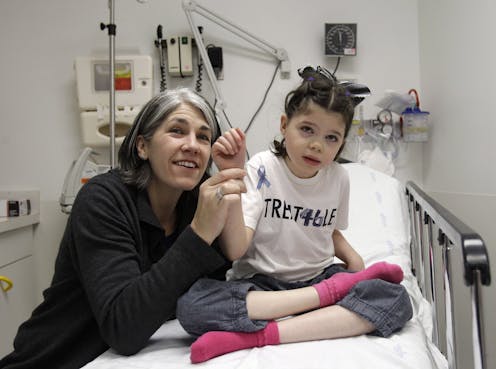What is 'right to try,' and could it help?
The 'right to try' legislation is a political winner. But will it give terminally patients the help they need or only bring false hope?

After a year in which President Donald Trump devoted much of his health policy attention to the repeal and replace of the Affordable Care Act, Trump used part of his recent State of the Union address to press Congress to focus attention in 2018 on a new health priority – the passage of “right to try” legislation.
Right to try legislation gives terminally ill patients the right to use experimental medications that have not yet been approved by the Food and Drug Administration. In 2017, the U.S. Senate unanimously passed HR 878, legislation that would do just that and the president’s address has pressured the U.S. House to follow suit, where a bill is now being debated in committee.
President Trump’s push for the passage of right to try nationally builds on the efforts of the Libertarian-leaning Goldwater Institute, which has used the broad popularity of the policy to help achieve passage of similar legislation in 38 states, even though it diverges with current federal regulations.
Despite these state gains and the policy’s growing popularity among states, ethical questions remain about the tangible impact of a federal right to try law on Americans with terminal illnesses. Most notably, a growing body of evidence from policy analysts argues that the legislation would unfortunately accomplish very little change for most patients, and it could actually make it harder to get new drugs approved in the future.
How the drug approval process works
Pharmaceuticals in the United States are regulated by the FDA. When a drug company develops a new compound intended for patient use, the medication goes through three phases of clinical trials that often take years to complete.
The first phase of trials requires a company to prove the drug is relatively safe for humans – that the drug itself will not poison the patient. These phase 1 trials are often conducted on as few as 30 patients.
In later phases, the clinical trials test whether the drug is effective at treating the condition for which it is intended without problematic side effects. It is at this stage that the vast majority of drugs fail to pass approval, because many drugs turn out to be ineffective or to cause severe side effects.

The right to try legislation the Trump administration is currently pushing would authorize doctors to administer drugs that have cleared the first phase, but which have not yet completed these later human clinical trials. By doing so, the legislation gives terminally ill patients the right to use potentially lifesaving medications without rigorous testing from the FDA and without years of waiting for the drugs to become commercially available.
For people suffering from terminal conditions such as amyotrophic lateral sclerosis, or ALS, for which there are promising treatments in the midst of the approval process, the legislation brings hope.

That said, we believe the promises made by right to try advocates are far greater than the actual impact it will have on patients.
‘Right to try’ grants no real rights
Despite good intentions – and the legislation’s name – right to try legislation grants no rights. It would merely grant permission for a patient to try to get experimental medication from a pharmaceutical company.
Patients would be allowed to try experimental drugs, but nothing in the legislation would make it mandatory for pharmaceutical companies to provide these medications.
The reasons for a company to withhold a drug are many. Giving access to preapproval drugs can be costly, particularly given the limited supply, and almost no medical insurance will cover experimental treatments. Access to the drugs will likely only be feasible for wealthy Americans who can afford to pay for the treatment, as well as the consequences of any negative side effects out of pocket.
Many drug companies also worry that making the drug available without approval opens them up to lawsuits if the drugs prove ineffective or have unforeseen side effects. The current federal right to try proposal does provide some protections for companies in this regard, but until those protections have been tested in court, it is likely companies will remain cautious.
Providing the drug to patients outside of clinical trials can also be disruptive to the approval process because it can lead to data on negative clinical outcomes outside the highly controlled trial setting. While new legislation prevents this data from being used unless it is deemed “critical to determining safety,” bad outcomes might give the FDA pause and delay the approval of drugs that might otherwise be available sooner.
The ‘right to try’ legislation changes very little
Beyond these issues, federal right to try legislation will have minimal impact on the availability of experimental drugs for patients. Not only have 38 states already passed similar legislation, but the FDA already has a program in place designed to provide patients with experimental medications.
This program, known as the “compassionate use” program, performs essentially the same function as the right to try legislation, allowing patients to try experimental drugs after approval from a review board and panel of experts. In recent years, the FDA has approved 5,816 of 5,849 requests – a 99.4 percent approval rate.
While right to try would eliminate the FDA’s role in this process, the legislation does little more than slightly simplify a process that already exists to ensure that those who need experimental medications have access to them.
More harm than good?
Ultimately, we believe right to try is poised to give the Trump administration a political win on a popular public policy but will do little to change the status quo for terminally ill patients. Some opponents say, if anything, it could give terminally ill patients false hope for new access to drugs they already can obtain through existing FDA policy.
Even if right to try does simplify federal regulation, patients must still convince a reticent pharmaceutical industry to provide drugs outside of trials, and patients must still bear the costs for these experimental treatments, which is out of reach for almost all Americans.
The right to try legislation will score the president and members on both sides of the aisle in Congress points, but ultimately it will change little for terminally ill patients and their families.
The authors do not work for, consult, own shares in or receive funding from any company or organization that would benefit from this article, and have disclosed no relevant affiliations beyond their academic appointment.

